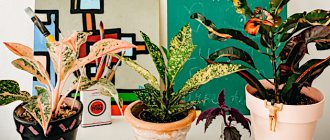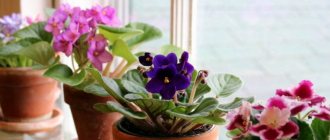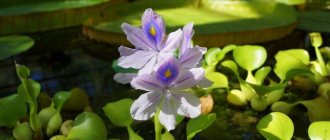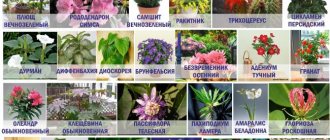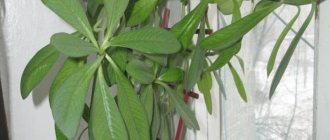Indoor plants are what add comfort and harmony to any home. Fresh flowers make a home more complete and enjoyable.
Monster
But if you want them to bloom and grow for a long time, you need to know their characteristics when planting and caring for them, because each plant with large leaves is different from each other.
Calamondin
A perennial tree of the oral family from East Asia, bred by crossing a kumquat with a mandarin orange. When grown at home, it reaches a height of 60-150 cm. The plant is distinguished by its juicy, dense greenery and bears fruit abundantly.
Calamondin does not tolerate direct sunlight and loves warmth. Feels best at a temperature of 18-20 ºC. In summer, the plant should be watered more abundantly than in winter.
Velvichia
Welwitschia amazing (lat. Welwítschia mirábilis) is a relict gymnosperm plant, the only modern species of the order Welwitschia of the Gnetaceae class. Velvichia grows in the southwest of Angola and in Namibia - within the rocky Namib Desert, stretching along the coast of the Atlantic Ocean.
Basically, its distribution area is limited to a narrow coastal strip along the western coast of Africa - from the vicinity of the city of Mosamedis in southern Angola to the southern tropics of Namibia. The plant is rarely found further than a hundred kilometers from the coast. This roughly corresponds to the limit reached by fogs, which are the main source of moisture for Velvichia, since precipitation here is extremely irregular and very little falls.
Only isolated specimens of Welwitschia are found in the interior regions of the Namib Desert, settling in the upper reaches of dry beds of temporary watercourses, where there is more precipitation. Here, after heavy rains, water collects in wide shallow depressions and the ground is moistened to a depth of 1.5-2 m. The leaves of the plant grow extremely slowly, growing up to 8 meters over centuries.
Dracaena fragrant
A tall plant of the Asparagus family, native to Africa. In room conditions it can grow up to two meters. It has a woody trunk and long narrow leaves at the top of the crown and around the trunk.
Prefers moderate lighting at temperatures from 18 to 25 ºC, and is not afraid of shadows. Dracaena is unpretentious in care; it requires regular moderate watering without waterlogging the soil and loosening. Water for watering this plant should be settled.
The most unpretentious
Hovea
An exotic palm tree is a wonderful decoration for any interior; it can be planted in a pot that will be combined with furniture elements. Or wrap it in a beautiful fabric to match the textiles in the room. Baskets or boxes are also a great option.
Sansevieria
A wonderful, unpretentious plant, a good option for the bedroom, because at night it releases oxygen. And its clean, clear lines on long, straight leaves will add elegance to the interior.
Tradescantia
An unpretentious ideal resident for southern windows. Its beautiful leaf color will play mesmerizingly in the sun. And for the interior it will be interesting natural lighting with shadows.
Dieffenbachia
A popular houseplant of the araceae family, imported from South America, named after a botanist from Germany. Loves light and warmth, but needs protection from the scorching rays of the sun.
The plant has thick stems with large variegated leaves. If the stem is damaged, it releases poisonous juice that can cause a burn if it comes into contact with the mucous membranes of the eyes, nose or mouth. Caring for Dieffenbachia is not difficult; just water the plant generously and maintain the room temperature at least 18 ºC.
Application in the interior
Most often, such plants are used as an independent composition, although many of them combine well with other flowers and fit perfectly into almost any interior. Below we will introduce you to popular indoor flowers with large leaves. Photos, names, descriptions of their features will help you choose a plant for your home. In addition, we will tell you about some secrets of caring for them.
You may be interested in: How to plant a geranium shoot without roots: features of care and propagation, tips and tricks
Sansevieria
A perennial ornamental plant without stems, popularly called “mother-in-law’s tongue.” The genus belongs to the agave family and includes approximately 60 species. Under natural conditions, the succulent can be found in Indonesia, India and Africa.
It has strong, long leaves that have the ability to store water, so it can easily tolerate skipping watering. The plant loves warmth and does not need frequent watering or replanting. The optimal temperature for keeping it is not lower than 18 ºC.
Coconut palm
Coconut palm (lat. Cōcos nucifēra) is a plant of the Palm family (Arecaceae);
the only species of the genus Cocos. The scientific name of the genus comes from the Portuguese word coco ("monkey") and is given because of the spots on the nut that make it look like a monkey's face. The species name nucífera comes from the Latin words nux (“nut”) and ferre (“to carry”). The origin of the coconut palm is unknown; it is believed to be native to Southeast Asia (Malaysia). Now it is widespread in the tropics of both hemispheres, both in cultivated and wild forms.
In the Philippines, the Malay Archipelago, the Malay Peninsula, India and Sri Lanka, it has been bred since prehistoric times. Coconut is a plant of sea coasts that prefers sandy soils, so the first place in production volumes by a large margin is occupied by a multi-island state with a vast coastal area - Indonesia (see below).
The expansion of its range occurred with the help of humans and naturally: coconuts are waterproof and float freely on the water, they are carried far by ocean currents, while maintaining vitality. Tall (up to 27-30 m) slender palm tree.
The trunk is 15-45 cm in diameter, smooth, ringed with fallen leaves, slightly inclined and widened at the base. There are no lateral branches, but supporting roots often develop below. The leaves are pinnately dissected, dense, 3-6 m long. There are from 20 to 35 leaves in the crown.
Philodendron
A heat-loving tropical plant, evergreen, with thick stems and large fleshy leaves. Most common in the Pacific Islands, Australia and America.
Due to its large size, philodendron can only be grown in a spacious room, using support for better growth. The plant prefers high air humidity, is heat-loving, does not tolerate drafts and requires regular watering.
Monstera
Monstera is another unusual and exotic plant brought to Europe from Central America. Monstera is easily recognizable among many other flowers due to its unusual appearance. Its large leaves are deeply cut and oblong in shape. Thanks to its beauty, Monstera has gained popularity among flower growers around the world. Since it is a tropical plant, it loves high humidity and warmth. Another distinctive feature of this flower is its aerial roots that grow above the soil. They should never be trimmed.
Calathea
An ornamental deciduous plant of the arrowroot family with large variegated leaves on long cuttings, distinguished by its grace. Calathea is quite capricious; it prefers a quiet place with moist air; low temperatures from 16 to 22ºC are suitable for it.
At higher indoor temperatures, it is recommended to periodically check the soil. Calathea should be fed with fertilizers from time to time, regularly sprayed and watered.
Large indoor plants for installation in the back of the room and near north-facing windows
Aglaonema, Aglaonema
Aglaonema is an evergreen, slow-growing herbaceous plant with leathery, patterned leaves. The inflorescences are not of great decorative value.
Variegated varieties are kept in very light, but not sunny places, while other varieties are kept in partial shade. The optimal maintenance temperature in summer is +20...+24 °C; in winter, the room temperature should be +14...+18 °C.
Aglaonemas do not tolerate solutions to make leaves shine, so it is preferable to clean them of dust by wiping them with a damp soft cloth.
Aglaonema
aglaonema
Anthurium, Anthurium
Anthurium is an evergreen herbaceous deciduous, ornamental and beautifully flowering plant with or without a trunk. Anthurium is popularly known as the flower of “male happiness.” Spathiphyllum is called “female happiness”; it is also a representative of the Araceae family.
The most commonly grown plant is Anthurium Andre , a plant of medium complexity that grows best in diffused light, in a place protected from drafts. To place the anthurium, choose a south or west window, well lit in winter (possibly with additional lighting), and in light shade in summer.
Anthurium forms a beautiful spreading bush.
Anthurium Andre
Aucuba, golden tree, Aucuba
Aucuba is an evergreen shrub or small tree with glossy, variegated yellow-green leaves.
Used as a pot plant for terraces, balconies and winter gardens. The young plant can be placed on the desktop.
Golden tree, or aucuba - a plant to attract success
Aucuba, or golden tree
Dieffenbachia
Dieffenbachia - plants from 50 to 150 cm in height with ovate-pointed leaves and strong stems. In cultivation, varieties have been obtained with exclusively decorative leaves, decorated with shapeless spots of white, yellow, fawn, and emerald along the bright green field.
It prefers light windows, protected from direct sunlight, but tolerates fairly deep shade, but without sunlight their color becomes less bright. The plant is kept at room temperature all year round, away from drafts. The optimal temperature in winter is +16…+18 °C.
Dieffenbachia
Dieffenbachia
Dracaena, Dracaena and Cordyline, Cordyline
Dracaenas and cordylines are evergreen perennial plants with a woody trunk and lanceolate or elongated oval leaves.
Dracaenas and cordylines grow well and reach large sizes indoors. This original plant, attractive with its exotic appearance, looks great in a composition with lower-growing crops: ferns, dieffenbachia, chlorophytum.
Dracaena: types, varieties and forms
dracaena in the interior
Codiaeum, croton, Codiaeum
Codiaum, Croton is an evergreen shrub up to 2 m high. It has large, up to 30 cm long, leathery, shiny leaves of various shapes, varying in color: from green to variegated with yellow, red, brown and almost black shades.
Codiaum is classified as an unpretentious and shade-tolerant plant. However, brightly colored varieties and forms retain their decorative properties only in good lighting, without direct sunlight.
Croton: care and care errors
Croton
Monstera
Monstera is an evergreen plant with climbing stems and large leathery leaves, often with hanging aerial roots.
The most common type is a powerful vine with large (up to 50 cm in diameter), long-petioled, dissected dark green leaves, which are entire when young.
Monstera rarely blooms indoors. After flowering, a fruit-cob is formed with sweet and sour violet berries densely sitting on it with the smell of pineapple. However, these berries irritate the mucous membrane of the mouth, so it is better not to eat them.
My favorite pet monster: simple rules for caring for a monstera
monstera in the house
Radermacher, Radermachera
Radermachera is a tree with beautiful double-pinnate leaves of lush green color. In phytodesign, Radermachera is used as a solitary plant.
Radermacher is placed in rooms with diffused light. Can tolerate short periods of shade. Perfect for office decoration. Watering is regular and moderate.
radermachera chinensis
Sansevieria, pike tail, mother-in-law's tongue, Sansevieria
Sansevieria is a rhizomatous, stemless perennial plant with hard, sword-shaped leaves collected in a basal rosette and cystic greenish-white inflorescences of fragrant flowers.
Sansevieria, pike tail or mother-in-law's tongue - the most indestructible plant for your home
sansevieria, or sansevieria
Fatsia, Aralia, Fatsia
Fatsia Japanese (Fatsia japonica) is an ornamental evergreen plant. In indoor conditions, fatsia reaches 90–120 cm in height. And its leaves grow up to 37 cm in diameter. Placed in light or semi-shaded rooms with winter temperatures of +10…+13 °C. The plant is shade-tolerant, but may not bloom in the shade. Fatsia prefers spacious containers.
fatsia japonica
Ficus, Ficus
Ficus - evergreen trees, shrubs, vines with small flowers and decorative leaves. Ficuses are one of the most popular plants in floriculture, since thanks to the variety of shapes and sizes, you can always choose a specimen that suits your interior.
Variety of ficuses: what can you grow in an apartment?
Ficus in the interior
Philodendron, Philodendron
Philodendron are plants divided into two large groups - trees and lianas. They have a variety of shapes and sizes, but all are distinguished by large decorative leathery leaves. Philodendrons are ideal plants for growing in apartments. There are many types and hybrids with which you can decorate any corner of your home. An easy-to-care plant.
philodendron
Schefflera, Schefflera
Schefflera is an annual tree or shrub with outstretched branches and palmately compound varnish-shiny light green leaves on long petioles. Used as foliage and ornamental plants for spacious rooms and winter gardens. Young specimens can also be kept in small rooms. Plants are valued for their fast growth and decorative appearance.
The main growing conditions are plenty of light, heat and humidity. In summer they are placed outside at a temperature of +15...+21 °C in a semi-shaded place, in winter - in winter gardens, offices or spacious rooms with good lighting and a temperature of +12...+16 °C.
Scheffler
Tradescantia
A climbing plant with creeping stems, reaching a considerable length and growing well in breadth thanks to regular pinching. The leaf plates are alternately located on the stem and can have a variety of shades and shapes.
A very sun-loving plant, it feels great at room temperature and does not tolerate frost. Requires moderate watering and periodic feeding in the summer.
Bulbous plants
“Look in the catalog for this variety of indoor flowers with photos and names: you will be surprised at the assortment of bulbous plants”
A popular category of house plants. There are representatives of bulbous plants on almost every windowsill. They are loved for their decorativeness and unpretentiousness. Look in the catalog for this variety of indoor flowers with photos and names: you will be surprised at the variety of bulbous plants. Among them there will always be successful solutions for decorating the most stylish rooms. Always great in any setting:
- wallota;
- eucomis;
- sprekelia;
- eucharis;
- clivia.
Vallota
A representative of amaryllis with belt-shaped leaves, the petioles of which at the bulbous base are burgundy in color. This is a flowering plant. In season, it produces a low peduncle with bright red, sometimes white or pink buds in a loose cluster. How beautiful these bulbous indoor flowers are, look at the photo.
Bulbous indoor flowers
Eucomis
This unusual-looking flower attracts attention with the brightness and shine of its green leaves. It seems that the plant has varnished ones
During the flowering period, eucomis throws out a powerful arrow with a tuft of leaves at the end. Small flowers delight with greenish-cream petals with purple splashes, and a kaleidoscopic sequence of buds opening.
Eucomis will be comfortable on southern windows
The asparagus species is most comfortable on the window sills facing south. He will also appreciate the uniformity of light watering.
Eucharis
In catalogs with photos and names, this variety of indoor flowers can be found as the Amazon lily. During the flowering period, the sophisticated bulbous plant is very similar to white narcissus and exudes pleasant aromas. The species is often used in interior decoration, since even during the dormant period its exterior looks impressive.
Eucharis exudes a pleasant aroma during flowering
Sprekelia
The gift of Mexican flora also resembles a lily. Sprekelia blooms with large flowers with deep red, velvety petals. A blossoming bud resembles a strange orchid. Find blooming indoor flowers in the photo to understand what we are talking about.
Sprekelia bud resembles an orchid
The plant is whimsical, requiring annual replanting, specific fertilizers, and fresh soil, but it’s worth tinkering with.
Clivia
The amaryllis perennial delights with charming red-orange flowers. The plant prefers to live in well-lit places, at a constant temperature and needs careful care. It is difficult to propagate clivia, since children are rarely formed on the mother bulb, and forced pollination is not always possible.
Clivia prefers well-lit places
Look for other bulbous flowers with names and photos in the catalog.
Japanese fatsia
A large ornamental deciduous plant with medium-sized palmate leaves - up to 35 cm. It is a similar genus of the Araliaceae family. All parts of the flower contain poison, so it is not recommended to place it in a child's room.
For maintenance, it is necessary to provide good lighting, humidify the air, regularly water, spray and fertilize once a week.
Large indoor plants are used to decorate rooms for various purposes. In addition, they perform very important functions: they purify the air and help create a positive emotional background. Palm trees and ficus trees are distinguished by their originality and can decorate any room in the apartment.
Anthurium
One of the exotic and beautiful tropical plants, which is also called flamingo flower. It owes its name to its unusual and beautiful appearance. Many people often wonder how to find out the name of a houseplant with unusually shaped flowers. Anthurium is one of the most magnificent plants in the flower world. Its leaves are quite large and heart-shaped, and its flowers are unusual. They are bright and shiny and resemble little hearts. Anthuriums come in different types and colors, so you can choose a flower for any interior.
Reproduction methods
Propagation of an unpretentious plant is best done in the spring, when nature comes to life. Among the types of propagation that involve rooting are:
- cuttings;
- removal of sockets.
Cuttings
Cuttings must be at least 18-23 cm in length. They have aerial roots. This side shoot is cut off and immediately placed in the prepared soil.
Recommendations for propagation by cuttings:
- The shoot is separated from the mother specimen with a knife wiped with alcohol.
- A large pot is being prepared.
- Drainage is laid out in the pot, and soil mixture for palm trees or peat soil mixed with sand is placed on it.
- The cutting is placed in the ground. The roots should not be completely in the soil.
- The pot with young pandanus is covered with a bag. It is important that there is a greenhouse temperature - about 30 degrees. Every day the sprout is opened and ventilated.
- Water once every 2 days.
- Rooting will occur in 50-80 days.
Removing sockets
Rosettes are formed on the mother plant in abundance. The collection takes place when the length of the daughter is at least 18 cm.
Rosettes in pots
Rosettes do not take root right away. It is important to wait 12-18 hours so that the roots dry out a little. Afterwards they are placed in a pot of soil, as in the case of cuttings. Covering with film is also mandatory.
Seeds
Pandanus can also be propagated by seeds. This method is suitable for the Useful type. Seeds are sown in a substrate of river sand and high-moor peat. The planting is watered and covered with film. Ventilate and water once every 24 hours. The sprouts sprout within a month. After another 40-80 days, they can be transplanted into a separate container.
Evergreen spreading pandan will decorate a spacious apartment. Even a beginner can cope with its cultivation. Pandanus care is simple. The main thing is not to expose it to bright sun, not to overwater it or overdry it, and to feed it on time.
